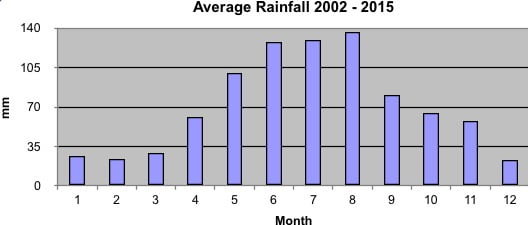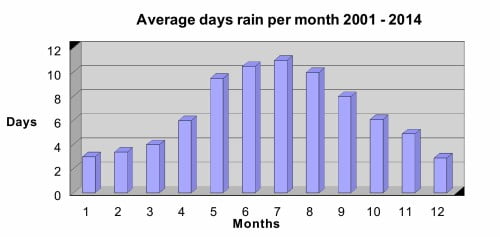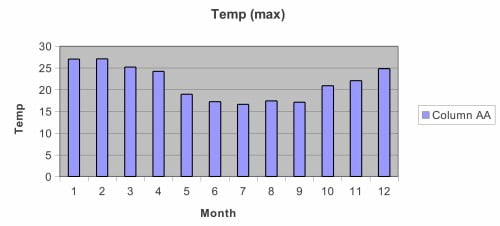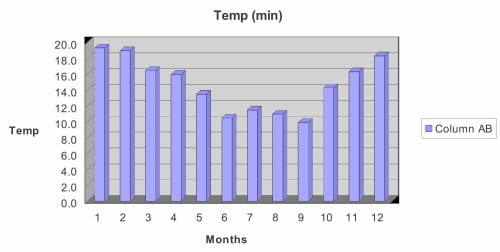Franschhoek
Franschhoek area information
Trails and Travel offer self-guided walking and cycling holidays in Franschhoek. It is known as the food and wine capital of South Africa. In 2014 the Franschhoek valley was listed by TripAdvisor as one of the top three destinations in South Africa. Read about their restaurant awards and the unique vegetation.The Cape Fynbos area, is the smallest but richest of the world’s six floral kingdoms.
Climate
Rainfall
The average rainfall per month, measured by us in Somerset West over the period 2002-2014 is shown below. Somerset West is 52 km from Franschhoek and a good indication of what can be expected in Franschhoek. The average rainfall in Somerset West was 890 mm over the 12 year period. May, June, July, August and September are the high rainfall months. The historic data indicate rain days of 8 to 11 per month during May to September in the Cape Winelands.

Temperature
An indication of the Franschhoek temperature is provided below. The graphs show the monthly statistics for Jonkershoek over the period 2008 -2010, provided by Cape Nature. It indicates that the coldest days can be expected from June to September and the warmest months are December to February.
Fauna and Flora
The Cape Floral Kingdom is the smallest but richest of the world’s six floral kingdoms. It covers only 0,04% of the earth’s surface. See Fynbos Gallery for pictures.
Fynbos
‘Fynbos’ is the Afrikaans word meaning ‘fine bush’, from the Dutch fijn bosch, which is descriptive of the fine-leafed, thick, shrub-like vegetation, which occurs in the winter rainfall area of the southern and south-western parts of the Western Cape, known as the Fynbos Biome. This characterises much of the vegetation you are about to see on the slopes of the mountains you will be walking through.
The majority of the plants are evergreen, sclerophyllous (hard-leaf) plants. It is remarkable that Fynbos plants grow in very poor soil, often derived from weathered sandstone. Over years the term ‘fynbos’ has persisted and has become synonymous with one of the richest and, possibly, most beautiful floras in the world.Fynbos grow in a 100-200km wide coastal belt stretching from Clanwilliam near the West coast to Port Elizabeth on the Southeast coast. It forms part of the Cape Floral Kingdom, where it accounts for half of the surface area and 80% of the plant varieties. The Fynbos in the western regions is more rich and varied than in the eastern regions of South Africa.
The diversity of fynbos plants is greater than that of the tropical rainforests, with over 9000 species of plants occurring in the area, around 6200 of which are endemic, i.e. do not occur anywhere else in the world. Of the Ericas, 658 (Cape Plants – Goldblatt & Manning 2000) , occur in the Fynbos Biome, while only 26 are found in the rest of the world. This is in an area of 70,000 km² – by comparison, the Netherlands, with an area of 33,000 km², has 1400 species, none of them endemic. Table Mountain in Cape Town supports 2200 species, more than the entire United Kingdom. Thus although the Fynbos comprises only 6% of the area of southern Africa it has half the species on the subcontinent, and in fact has almost 1 in 5 of all plant species in Africa.
Fynbos Plant Families
Three of the characteristic fynbos plant families are the proteas, Erica’s and restios. Proteas are represented by many species and are prominent in the landscape as one of the few, large-leafed plant types, generally with large striking flowersheads, which may be pollinated by birds. Ericas or heaths are generally smaller plants with many small, tubular flowers and needle-like leaves. The grass-like restios – only a few species of which are known outside the fynbos area – grow in wetter areas. More than 1400 bulb species occur among the fynbos, of which 96 are gladiolus and 54 lachenalias.
Fire is a necessary stage in the lives of almost all fynbos plants, and is common during the dry summer months. Many of the seeds germinate only after the intense heat of a fire. In readiness for fire, most proteas retain their seeds on the bush for at least one year, a habit known as serotiny. They do this in structures which resemble the original flowerheads. In some species these structures are strikingly beautiful and long-lasting, which accounts for their use in dried floral arrangements.
Threats to Fynbos
The major threat to fynbos is the spread of alien plants, such as hakea, the Australian wattles Acacia cyclops, commonly known as rooikrans and Acacia saligna commonly known as Port Jackson, and pine trees from Europe.Other significant threats include too frequent fires and fires in the wrong season; commercial afforestation; and the development of housing estates and farms.
An important aspect of fynbos conservation is that many species have such a tiny range that ploughing a field, or building a single house can wipe out the entire world population of a unique form of life. Part of the dilemma is whether or not to tell members of the public where a rare species occurs so that they can keep an eye on it. This may put the species at risk to unscrupulous collectors and cultivators. The alternative of keeping this knowledge secret might lead to sympathetic landowners destroying plants out of ignorance. The Cape Flora is ecologicaly very delicately balanced. Alien species readily become established in fynbos and displace the native plants and animals. As a result of this, combined with the naturally limited range of many species, urbanisation and the spread of agriculture, numerous fynbos plants are now seriously endangered or extinct.
Renosterveld
Renosterveld tends to occur where rainfall is between 250 (rarely to 200 mm) to 600 mm per year and at least 30% falls in winter. Where the rainfall is higher, the soil becomes leached and Renosterveld is replaced by Asteraceous Fynbos. Renosterveld is characterized by the dominance of members of the Daisy Family (Asteraceae) specifically one species – Renosterbos Elytropappus rhinocerotis, from which the vegetation type gets its name. Although Renosterbos is the characteristic dominant, many other plants are prominent – for instance in the Daisy Family (Asteraceae). Proteas, Ericas and Restios – typical of Fynbos – tend to be absent in Renosterveld, or are present at very low abundances
Vignerons de Franschhoek
As you make your way into Franschhoek you will notice that most of the farms still bear their original French names, some complete with a spectacular Cape Dutch homestead, towering oaks and rolling vineyards. You will find an array of cellars, ranging from quaint boutique wineries that cater for those in search of something unique, to the large cellars that offer visitors organised tours and tastings.
The fertile Franschhoek Wine Valley is home to some of South Africa’s noble cultivars and classic styles. These range from superb whites such as Sauvignon Blanc, Chardonnay, Semillon and Chenin Blanc, to the full-bodied reds of Cabernet Sauvignon, Shiraz, Pinot Noir and Merlot. The area also produces some of the country’s extraordinary Méthode Cap Classiques, which can all be enjoyed during a trip along the Franschhoek MCC Route.
The wines made by the Vignerons de Franschhoek can be tasted, paired with wonderful food available from Franschhoek’s restaurants, many of which are found on the wine estates. Have a look at the Franschhoek Food and Wine Route for more options.
Source: Franschhoek Wine Valley 48 estates listed
Restaurants
Franschhoek restaurants take food very seriously. Franschhoek boasts some of South Africa’s ‘Top 100’ restaurants and has become known as South Africa’s Culinary Capital, providing visitors with a memorable dining experience. Leading chefs create everything from cutting-edge cuisine to stylish light meals, using only the freshest local produce paired with superb local wines. Franschhoek is also a member of The Délice Network of Good Food Cities of the World. Délice is an international network of likeminded cities engaged in promoting the benefits of culinary excellence and good food. Franschhoek was granted membership to this prestigious network in October 2014, and is the only member in the Southern Hemisphere.
Franschhoek also offers visitors diverse culinary experiences through its festivals such as the Franschhoek Bastille Festival, The Franschhoek Cap Classique & Champagne Festival, as well as its routes – the Food and Wine Route, the Artisan Food Route, and Franschhoek Rond en Bont. The Franschhoek Artisan Food Route, in particular, exposes the visitor to a range of the finest olives, cheeses, chocolates, charcuterie and artisanal breads South Africa has to offer.
Internationally acclaimed chefs who include Reuben Riffel (Reuben’s Restaurant), Chris Erasmus (Foliage Restaurant), Darren Badenhorst (Le Coin Francais), Scot Kriton and John Norris-Rogers (La Petite Colombe), Liam Tomlin and David Schneider (Chefs Warehouse at Maison) as well as Christiaan Campbell (The Werf Restaurant at Boschendal) are based in Franschhoek, adding further acclaim to the area.
Source: Franschhoek Wine Valley 52 restaurants listed
Go back to the top of the page



